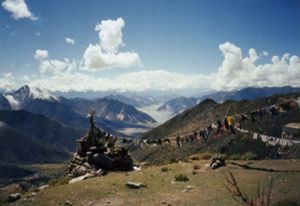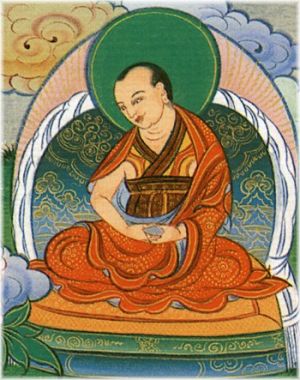Longchenpa
| This section contains Tibetan script. Without proper Tibetan rendering support configured, you may see other symbols instead of Tibetan script. |
Longchenpa (Tib. ཀློང་ཆེན་པ་, Wyl. klong chen pa), also known as Longchen Rabjam (Tib. ཀློང་ཆེན་རབ་འབྱམས་, klong chen rab 'byams), ‘Infinite, Vast Expanse of Space’, or Drimé Özer (1308-1364), was one of the most brilliant teachers of the Nyingma lineage. He systematized the Nyingma teachings in his ‘Seven Treasures’ and wrote extensively on Dzogchen. He transmitted the Longchen Nyingtik cycle of teachings and practice to Jikmé Lingpa, and it has since become one of the most widely practised of traditions.
目錄
Biography
The immediate reincarnation of Pema Ledreltsal, Longchenpa is regarded as an indirect incarnation of the princess Pema Sal. He was born in the Tra Valley of Southern Tibet to master Tenpasung, an adept at both the sciences and the practice of mantra, and Dromza Sonamgyen, who was descended from the family of Dromtönpa Gyalwé Jungné. Longchenpa was first ordained at the age of eleven and studied extensively with the Third Karmapa, Rangjung Dorje. He received not only the Nyingma transmissions as passed down in his family, but also studied with many of the great teachers of his day. He received the combined Kadam and Sakya teachings of the Sutrayana through his main Sakya teacher, Lama Dampa Sonam Gyaltsen, in addition to the corpus of both old and new translation tantras. At the age of nineteen, Longchenpa entered the famous shedra Sangphu Neuthok, where he acquired great scholarly wisdom. He later chose to practise in the solitude of the mountains, after becoming disillusioned by the behaviour of some scholars.
During his late twenties two events occurred that were to be of decisive importance in his intellectual and spiritual development. One was a vision of Guru Padmasambhava and Yeshe Tsogyal, and the other was his meeting with the great Rigdzin Kumaradza. It was in the mountains that he met Rigdzin Kumaradza, who was travelling from valley to valley leading his students through the most difficult of circumstances. Together with Rangjung Dorje, Longchenpa accompanied them for two years, during which time he received all of Rigdzin Kumaradza's transmissions and underwent tremendous hardship.
After several years in retreat, Lonchenpa attracted more and more students, even though he had spent nearly all of his life in mountain caves. During a stay in Bhutan (Tib., Mon), Longchenpa founded several monasteries, including Tharpaling near Bumthang, and fathered two children, his son Tulku Drakpa Özer (b. 1356), going on to become a holder of the Nyingtik lineage.
The events leading up to Longchenpa's parinirvana are recorded in a text known as The Immaculate Radiance which includes these lines:
- My delight in death is far, far greater than
- The delight of traders at making vast fortunes at sea,
- Or the lords of the gods who vaunt their victory in battle;
- Or of those sages who have entered the rapture of perfect absorption.
- So just as a traveller who sets out on the road when it is time,
- I, Pema Ledrel Tsal, will not remain in this world any longer,
- But will go to dwell in the stronghold of the great bliss of deathlessness.
Legacy
Sogyal Rinpoche writes:
- The figure of Longchen Rabjam stands out as one of the greatest Dzogchen masters in the Nyingma tradition, and amongst the most brilliant and original writers in Tibetan Buddhist literature. He was the author of over 200 works, of which only about twenty-five survive, and amongst which the Seven Treasuries (Tib. མཛོད་བདུན་ Dzö Dun) and Three Trilogies are most well-known. It was he who brought together into a cohesive system the teachings of Vima Nyingtik and Khandro Nyingtik, on which he wrote the ‘Three Yangtik’ or Inner Essences.
- As Nyoshul Khen Rinpoche explains: “Kunkhyen Longchenpa’s Seven Treasuries (Dzö Dun) were written to elucidate the extraordinarily profound meaning of the seventeen main Tantras of Dzogpachenpo as well as the teachings of all Nine Yanas. For the purpose of the actual practice of Dzogchen according to these Tantras, Longchenpa gathered his own termas as well as those of Chetsün Senge Wangchuk (who was later reborn as Jamyang Khyentse Wangpo) and Pema Lédrel Tsal (Longchenpa’s previous incarnation) in the form of the thirteen volume collection known as the Nyingtik Yabshyi. This Yabshyi is the practice aspect of Longchenpa’s writings, and the basis of the Old Nyingtik. In it he synthesized the Vima Nyingtik of Vimalamitra and the Khandro Nyingtik of Guru Rinpoche and explained all the practical details in the light of his own realization.”[1]
His Writings

- Seven Treasures
- The Wish Fulfilling Treasury (Tib. ཡིད་བཞིན་མཛོད་, Yishyin Dzö; Wyl. yid bzhin mdzod)
- The Treasury of Pith Instructions (Tib. མན་ངག་མཛོད་, Mengak Dzö; Wyl. man ngag mdzod)
- The Treasury of Dharmadhatu (Tib. ཆོས་དབྱིངས་མཛོད་, Chöying Dzö; Wyl. chos dbyings mdzod)
- The Treasury of Philosophical Tenets (Tib. གྲུབ་མཐའ་མཛོད་, Drubta Dzö; Wyl. grub mtha' mdzod)
- The Treasury of the Supreme Vehicle (Tib. ཐེག་མཆོག་མཛོད་, Tekchok Dzö; Wyl. theg mchog mdzod)
- The Treasury of Word and Meaning (Tib. ཚིག་དོན་མཛོད་, Tsik Dön Dzö; Wyl. tshig don mdzod)
- The Treasury of the Natural State (Tib. གནས་ལུགས་མཛོད་, Neluk Dzö; Wyl. gnas lugs mdzod)
- Trilogy of Dispelling Darkness
- Dispelling Darkness in the Ten Directions (Tib. གསང་སྙིང་འགྲེལ་པ་ཕྱོགས་བཅུ་མུན་སེལ་, gsang snying 'grel pa phyogs bcu mun sel)
- Dispelling Darkness of the Mind (Tib. གསང་སྙིང་སྤྱི་དོན་ཡིད་ཀྱི་མུན་སེལ་, gsang snying spyi don yid kyi mun sel)
- Dispelling Darkness of Ignorance (Tib. གསང་སྙིང་བསྡུས་དོན་མ་རིག་མུན་སེལ་, gsang snying bsdus don ma rig mun sel)
- Trilogy of Finding Comfort and Ease
- Finding Comfort and Ease in the Nature of Mind (Tib. སེམས་ཉིད་ངལ་གསོ, Wyl.sems nyid ngal gso)
- Finding Comfort and Ease in Meditation (Tib. བསམ་གཏན་ངལ་གསོ་, Wyl. bsam gtan ngal gso)
- Finding Comfort and Ease in the Illusoriness of Things (Tib. སྒྱུ་མ་ངལ་གསོ་, Wyl. sgyu ma ngal gso)
- Trilogy of Natural Freedom
- The Natural Freedom of the Nature of Mind (Tib. སེམས་ཉིད་རང་གྲོལ་, Semnyi Rangdrol)
- The Natural Freedom of Reality (Tib. ཆོས་ཉིད་རང་གྲོལ་, Chönyi Rangdrol)
- The Natural Freedom of Equality (Tib. མཉམ་ཉིད་རང་གྲོལ་, Nyamnyi Rangdrol)
- A Collection of Writings (Tib. གསུང་ཐོར་བུ་, Wyl. gsung thor bu)
- Thirty Pieces of Advice from the Heart (Tib. སྙིང་གཏམ་སུམ་ཅུ་པ་, Wyl. snying gtam sum cu pa)
Alternative Names
Longchenpa used several different names in the colophons to his writings, often corresponding to the subject matter of the text:[2]
- Dorje Ziji (Tib. རྡོ་རྗེ་གཞི་བརྗིད་, rdo rje gzi brjid) for writings common to both outer and inner tantras.
- Drimé Özer (Tib. དྲི་མེད་འོད་ཟེར་, dri med 'od zer) for writings on profound subjects and especially the stages of meditation.
- Longchen Rabjam (Tib. ཀློང་ཆེན་རབ་འབྱམས་, klong chen rab 'byams) for writings in which the inconceivable nature is taught in detail.
- Kunkhyen Ngakgi Wangpo (Tib. ཀུན་མཁྱེན་ངག་གི་དབང་པོ་, kun mkhyen ngag gi dbang po) for writings in which the various yanas and views are explained in detail.
- Tsultrim Lodrö (Tib. ཚུལ་ཁྲིམས་བློ་གྲོས་, tshul khrims blo gros) or Samyepa Tsultrim Lodrö, for writings on the outer sciences.
Notes
- ↑ Dzogchen and Padmasambhava
- ↑ Tulku Thondup, The Practice of Dzogchen, p.188
Teachings Given to the Rigpa sangha
- Khenpo Pema Sherab, Teachings on Longchenpa's Advice from the Heart, Lerab Ling, August 2009
- Nyoshul Khen Rinpoche, Lerab Ling, 17 August 1996
Further Reading
In English
- Dudjom Rinpoche, The Nyingma School of Tibetan Buddhism, Its Fundamentals and History, trans. and ed. Gyurme Dorje (Boston: Wisdom, 1991), pp.575-596
- Ehrhard, Franz-Karl. The Oldest Known Block Print of Klong-chen Rab-'byams-pa's Theg mchog mdzod: Facsimile Edition of Early Tibetan Block Prints, with an Introduction by Franz-Karl Ehrhard, Lumbini International Research Institute, Lumbini: 2000
- Germano, David and Gyatso, Janet, "Longchenpa and the Possession of the Ḍākinīs" in in David Gordon White (ed.) Tantra in Practice, Princeton University Press, 2000
- Klong-chen rab-'byams-pa, Looking Deeper: A Swan's Questions and Answers, translated by Herbert V. Guenther, Timeless Books, 1983
- Longchen Rabjampa, 'The Four-Themed Precious Garland: An Introduction to Dzogchen, with commentaries by Dudjom Rinpoche and Beru Khyentse Rinpoche; translated by Alexander Berzin, LTWA, 1978
- Longchenpa, You Are the Eyes of the World, translated by Kennard Lipman and Merrill Peterson, Snow Lion, 2000
- Mackenzie Stewart, Jampa, The Life of Longchenpa: The Omniscient Dharma King of the Vast Expanse (Ithaca: Snow Lion, 2014)
- Nyoshul Khenpo, A Marvelous Garland of Rare Gems: Biographies of Masters of Awareness in the Dzogchen Lineage, Padma Publications, 2005
- Smith, E. Gene, 'Klong chen Rab 'byams pa and His Works' in Among Tibetan Texts, Wisdom, 2001
- Tulku Thondup, Masters of Meditation and Miracles, Shambhala, pages 109-117.
- Tulku Thondup, The Practice of Dzogchen (Ithaca: Snow Lion, 1989)
In French
- Stéphane Arguillère, Vaste sphère de profusion, Klong-chen rab-'byams (Tibet, 1308-1364), sa vie, son oeuvre, sa doctrine, Orientalia Analecta Lovaniensa 167, Leiden: Peeters, 2007
